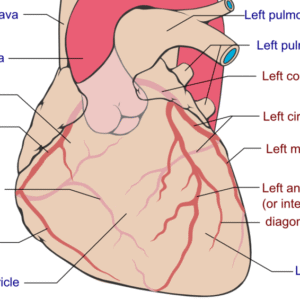Cardiology > Wolff-Parkinson-White Syndrome (WPWS)
Wolff-Parkinson-White Syndrome (WPWS)
Background
Wolff-Parkinson-White syndrome is a type of pre-excitation disorder characterized by the presence of an accessory conduction pathway (the bundle of Kent) between the atria and ventricles, bypassing the atrioventricular (AV) node. This allows for early ventricular depolarization and may predispose patients to tachyarrhythmias, particularly atrioventricular reentrant tachycardia (AVRT).
II) Classification/Types
By Electrophysiological Characteristics:
- Manifest WPW: Classic delta wave and short PR interval on ECG.
- Concealed WPW: No baseline ECG changes; accessory pathway conducts retrogradely only, revealed during tachyarrhythmia.
By Arrhythmia Type:
- Orthodromic AVRT: Most common; impulse travels down the AV node and up the accessory pathway (narrow QRS).
- Antidromic AVRT: Impulse travels down the accessory pathway and up the AV node (wide QRS).
- Atrial Fibrillation with WPW: Can cause dangerously fast ventricular rates due to bypassing AV nodal filtering.
Pathophysiology
WPW arises from embryologic failure of fibrous insulation between atria and ventricles, resulting in an accessory pathway. This allows impulses to reach the ventricles prematurely, bypassing the AV node. During reentrant arrhythmias, the circuit uses the AV node and accessory pathway alternately, enabling sustained tachycardia.
Epidemiology
- Prevalence: ~0.1–0.3% in the general population.
- More common in males and younger individuals.
- May be associated with structural abnormalities (e.g., Ebstein anomaly) or occur sporadically.
- Many remain asymptomatic throughout life.
Etiology
I) Causes
- Congenital accessory pathways (Bundle of Kent)
- Familial WPW (rare; autosomal dominant with PRKAG2 gene mutations)
- Congenital heart defects (e.g., Ebstein anomaly)
II) Risk Factors
- Family history of pre-excitation syndromes
- Structural heart disease
- Physical or emotional stress (may trigger arrhythmia)
- Use of AV nodal blocking agents during atrial fibrillation
Clinical Presentation
I) History (Symptoms)
- Palpitations (sudden onset/offset)
- Syncope or presyncope
- Dizziness or lightheadedness
- Chest discomfort or dyspnea during tachycardia
- Sudden cardiac arrest (rare, typically in atrial fibrillation with WPW)
II) Physical Exam (Signs)
- Often normal between episodes
- Rapid heart rate during tachyarrhythmia
- Hypotension or signs of poor perfusion during sustained arrhythmia
Differential Diagnosis (DDx)
- AV nodal reentrant tachycardia (AVNRT)
- Atrial fibrillation or flutter
- Ventricular tachycardia
- Sinus tachycardia
- Long QT syndrome
- Catecholaminergic polymorphic VT
Diagnostic Tests
Initial Work-Up
12-lead ECG (in sinus rhythm):
- Short PR interval (<120 ms)
- Delta wave (slurred upstroke of QRS)
- Prolonged QRS duration (>120 ms)
Ambulatory ECG or Event Monitor:
- Useful in patients with intermittent symptoms
Echocardiogram:
- Assess for associated congenital heart disease (e.g., Ebstein anomaly)
Advanced Testing
Electrophysiology Study (EPS):
- Gold standard for identifying location and properties of accessory pathways
- Risk stratification and pathway ablation planning
Exercise Stress Test:
- May assess for disappearance of pre-excitation at high rates (suggests lower risk)
Treatment
I) Acute Management
- Stable AVRT: Vagal maneuvers → IV adenosine → Beta-blockers or calcium channel blockers (if no pre-excitation on baseline ECG)
- Unstable Tachycardia: Immediate synchronized cardioversion
- Atrial Fibrillation with WPW:
- Avoid AV nodal blockers (risk of accelerating conduction down the accessory pathway)
- Use IV procainamide or ibutilide
- Cardioversion if hemodynamically unstable
II) Chronic Management
- Asymptomatic WPW: Observation vs. EPS for risk stratification
- Symptomatic WPW or High-Risk Features:
- Catheter ablation of accessory pathway (curative in >95%)
- Beta-blockers or antiarrhythmics (e.g., flecainide) if ablation not feasible
Medications
Drug Class | Examples | Notes |
AV nodal blockers | Adenosine, beta-blockers | Use in AVRT without WPW-related AF |
Class IC antiarrhythmics | Flecainide, propafenone | Effective for prevention; avoid in structural heart disease |
Class III antiarrhythmics | Amiodarone, ibutilide | Used in AF with WPW; monitor QT |
Sodium channel blockers | Procainamide | Acute AF with WPW treatment |
Device Therapy
- Not typically indicated
- ICD may be needed in rare cases with aborted sudden cardiac arrest or coexisting channelopathy
Patient Education, Screening, Vaccines
Education:
- Avoid AV nodal blockers unless directed by cardiologist
- Recognize early signs of tachycardia or dizziness
- Understand the role of ablation and its curative potential
Screening/Prevention:
- Family screening not routine but may be considered in familial WPW
- EPS in athletes or high-risk occupations (e.g., pilots)
Vaccinations:
- Routine adult immunizations recommended
- No WPW-specific vaccines
Consults/Referrals
- Cardiology: Initial management and risk stratification
- Electrophysiology: For EPS and ablation
- Emergency Medicine: For acute arrhythmia management
- Genetics: If familial WPW suspected
Follow-Up
Short-Term
- Monitor post-ablation symptoms and ECG changes
- Repeat Holter if symptoms persist
Long-Term
- No ongoing therapy needed after successful ablation
- Periodic ECG in asymptomatic patients not typically required unless clinical changes
Prognosis
- Excellent with catheter ablation
- Recurrence rate post-ablation <5%
- Risk of sudden cardiac death is low but higher in patients with atrial fibrillation and rapidly conducting accessory pathways
- Asymptomatic WPW generally has a favorable outcome but warrants risk stratification
Stay on top of medicine. Get connected. Crush the boards.
HMD is a beacon of medical education, committed to forging a global network of physicians, medical students, and allied healthcare professionals.

